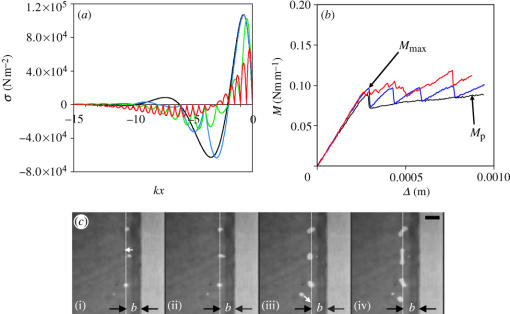Figure 2.
(a) Variation of the normal stress at the interface between the rigid plate and the laterally incised elastomeric film as a function of dimensionless distance from the edge (kx), showing alternating regions of tension and compression. The bubbles nucleate where the tensile stress is maximum, which is slightly inside the edge of the film. These calculations are done for sk=∞ (black), sk=2.0 (blue), sk=1.0 (green) and sk=0.5 (red). (b) The moment–displacement (M–Δ) data for the PDMS films (h=150 μm, μ=0.9 MPa) of different incision widths (black: sk=∞, blue: sk=10, and red: sk=0.5). The saw-tooth characteristics in the blue curve can be decomposed into individual behaviours of edge cracks having different initial arm lengths. When sk=0.5, we see stick–slip behaviour that involves saw-tooth-like peaks with much smaller amplitude. The crack propagation moment is maintained nearly at the same level as that of the crack initiation moment (Mmax). (c) The bubbles, cavitated either right or left of the line denoted as x=−b, move towards the line where the pressure has a local minimum. The scale bar in (c) is 300 μm.

